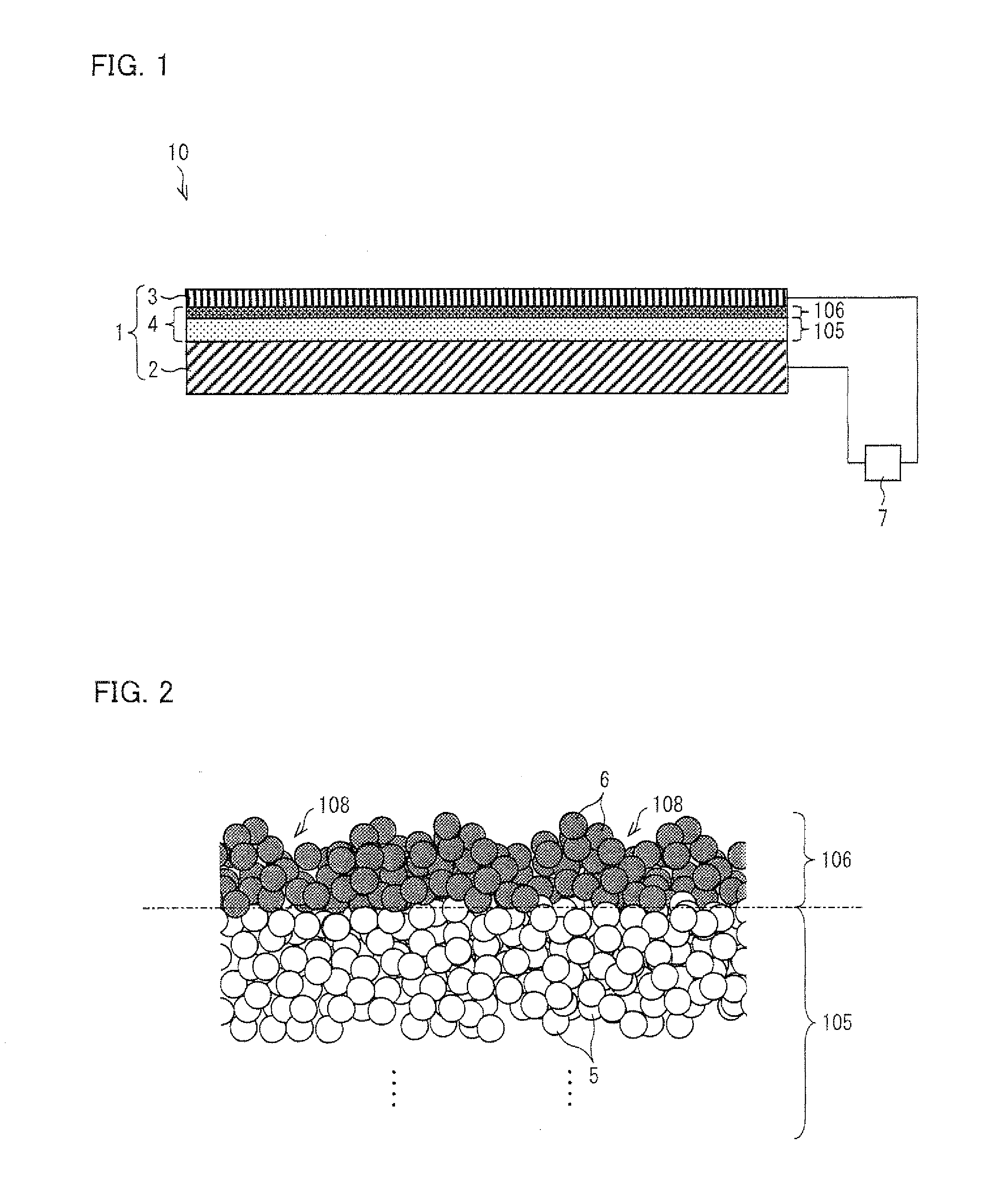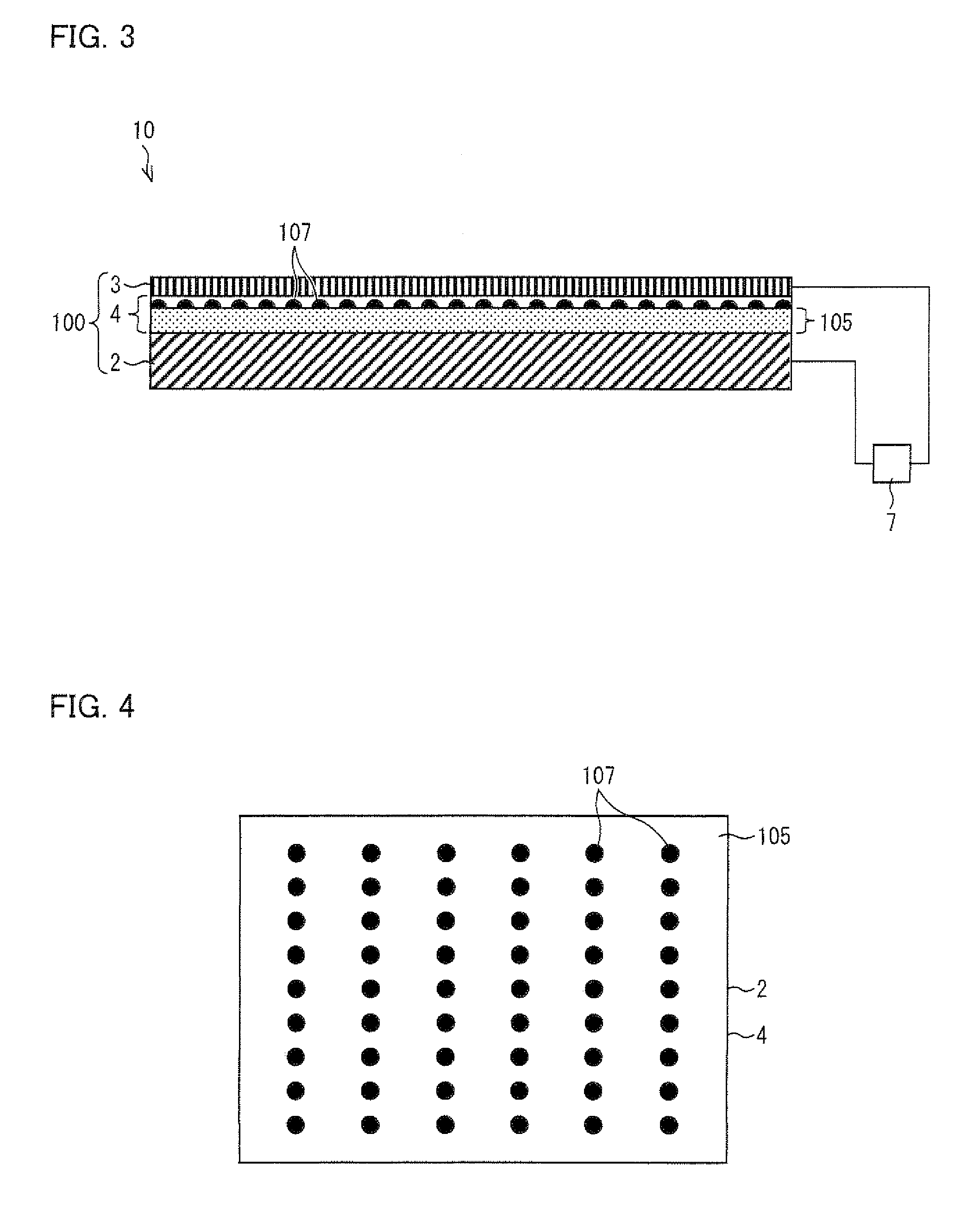Electron emitting element and method for producing electron emitting element
a technology of electron emitting element and electron emitting device, which is applied in the manufacture of electrode systems, discharge tubes luminescnet screens, instruments, etc., can solve the problems of oxidizing various substances, breaking down of electron emitting elements, and ozone being harmful to human bodies, etc., to achieve stable electron emission characteristic, facilitate electricity flow, and facilitate formation
- Summary
- Abstract
- Description
- Claims
- Application Information
AI Technical Summary
Benefits of technology
Problems solved by technology
Method used
Image
Examples
embodiments 1 , 2
Embodiments 1, 2
[0061]FIG. 1 is a schematic view illustrating a configuration of an electron emitting device 10 including an electron emitting element 1 according to one embodiment of the present invention.
[0062]As illustrated in FIG. 1, the electron emitting device 10 includes an electron emitting element 1 according to one embodiment of the present invention, and a power supply 7. The electron emitting element 1 includes: an electrode substrate 2 as a bottom electrode; a thin-film electrode 3 as an upper electrode; and an electron acceleration layer 4 sandwiched therebetween. The power supply 7 applies a voltage between the electrode substrate 2 and the thin-film electrode 3.
[0063]While the voltage is applied between the electrode substrate 2 and the thin-film electrode 3, current flows in the electrode acceleration layer 4 sandwiched between the electrode substrate 2 and the thin-film electrode 3. A part of electrons in the current is emitted from the electron acceleration layer ...
example 1
[0144]Into a 10-mL reagent bottle, 2.0 g of an ethanol solvent and 0.5 g of tetramethoxysilane KBM-04 (manufactured by Shin-Etsu Chemical Co., Ltd.) were added. Further, as insulating fine particles 5, 0.5 g of spherical silica particles AEROSIL R8200 (manufactured by Evonik Degussa Japan Co., Ltd.) having an average diameter of 12 nm were added to the reagent bottle, and the reagent bottle was set in an ultrasonic dispersion device, so as to obtain an insulating fine particle dispersion solution A.
[0145]Then, the insulating fine particle dispersion solution A was dropped onto a 25 mm-square glass substrate having an ITO thin film on its surface, as the electrode substrate 2, and the glass substrate was subjected to spin-coating at 8000 rpm and 10 s so as to form a silica particle layer as the fine particle layer 105. Then, the glass substrate was dried at a room temperature for a few hours.
[0146]Subsequently, a tetradecane dispersion solution (manufactured by ULVAC, Inc., an averag...
example 2
[0157]As Example 2, an electron emitting element of Sample #2 was formed almost in the same procedure as in Example 1, except that the basic solution was not applied to the silica particle layer having a number of silver-particle domes. In Example 2, in the atmospheric forming process, a crack or a split could be formed in a silver-particle dome and electron emission in vacuum could be observed. However, it was difficult to control current flowing in the element and to control a degree of the crack or the split formed in the silver-particle dome.
PUM
 Login to View More
Login to View More Abstract
Description
Claims
Application Information
 Login to View More
Login to View More - R&D
- Intellectual Property
- Life Sciences
- Materials
- Tech Scout
- Unparalleled Data Quality
- Higher Quality Content
- 60% Fewer Hallucinations
Browse by: Latest US Patents, China's latest patents, Technical Efficacy Thesaurus, Application Domain, Technology Topic, Popular Technical Reports.
© 2025 PatSnap. All rights reserved.Legal|Privacy policy|Modern Slavery Act Transparency Statement|Sitemap|About US| Contact US: help@patsnap.com



